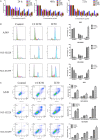Herbal formula Yangyinjiedu induces lung cancer cell apoptosis via activation of early growth response 1
- PMID: 31237749
- PMCID: PMC6714142
- DOI: 10.1111/jcmm.14501
Herbal formula Yangyinjiedu induces lung cancer cell apoptosis via activation of early growth response 1
Abstract
Traditional Chinese Medicine (TCM) has been extensively used in clinical practices and proven to be effective against cancer. However, the underlying mechanisms remain to be investigated. In this study, we examined the anticancer activities of Chinese herbal formula Yangyinjiedu (YYJD) and found that YYJD exhibits cytotoxicity against lung cancer cells. Transcriptome analysis indicated that 2178 genes were differentially expressed (P < 0.05) upon YYJD treatment, with 1464 being (67.2%) up-regulated. Among these, we found that the tumour suppressor early growth response 1 (EGR1) is the most activated. We demonstrated that EGR1 contributes to YYJD-induced apoptosis in A549. Through dissecting EGR1-associated transcriptional network, we identified 275 genes as EGR1 direct targets, some targets are involved in apoptosis. Lastly, we observed that YYJD enhances EGR1 expression and induces cell death in tumour xenografts. Collectively, these findings suggest that YYJD exerts its anticancer activities through EGR1 activation, thus providing the evidence for its potential clinical application for lung cancer patients.
Keywords: ChIP-seq; EGR1; lung cancer; traditional Chinese medicine; transcriptome.
© 2019 The Authors. Journal of Cellular and Molecular Medicine published by John Wiley & Sons Ltd and Foundation for Cellular and Molecular Medicine.
Conflict of interest statement
The authors declare that they have no competing interests.
Figures





Similar articles
-
Herbal formula YYJD inhibits tumor growth by inducing cell cycle arrest and senescence in lung cancer.Sci Rep. 2017 Jul 10;7(1):4984. doi: 10.1038/s41598-017-05146-x. Sci Rep. 2017. PMID: 28694520 Free PMC article.
-
Traditional Chinese medicine Ze-Qi-Tang formula inhibit growth of non-small-cell lung cancer cells through the p53 pathway.J Ethnopharmacol. 2019 Apr 24;234:180-188. doi: 10.1016/j.jep.2019.01.007. Epub 2019 Jan 17. J Ethnopharmacol. 2019. PMID: 30660711
-
Induction of Senescence in Lung Cancer Cells by Qidongning Formula via the Transcription Factor EGR1.Integr Cancer Ther. 2025 Jan-Dec;24:15347354241307007. doi: 10.1177/15347354241307007. Integr Cancer Ther. 2025. PMID: 40029995 Free PMC article.
-
Antitumor effect of traditional Chinese herbal medicines against lung cancer.Anticancer Drugs. 2014 Oct;25(9):983-91. doi: 10.1097/CAD.0000000000000127. Anticancer Drugs. 2014. PMID: 24892722 Review.
-
Anticancer Properties of Traditional Chinese Medicine.Comb Chem High Throughput Screen. 2017;20(5):423-429. doi: 10.2174/1386207320666170116141818. Comb Chem High Throughput Screen. 2017. PMID: 28093974 Review.
Cited by
-
Exploration of the Molecular Mechanism of Danzhi Xiaoyao Powder in Endometrial Cancer through Network Pharmacology.Evid Based Complement Alternat Med. 2022 Jun 13;2022:8330926. doi: 10.1155/2022/8330926. eCollection 2022. Evid Based Complement Alternat Med. 2022. PMID: 35774749 Free PMC article.
-
Dipeptide PA3264 derived from rare and endangered Squama Manis is a novel bioactive peptide for the treatment of triple-negative breast cancer.Chin Med. 2024 Aug 21;19(1):112. doi: 10.1186/s13020-024-00979-x. Chin Med. 2024. PMID: 39169391 Free PMC article.
-
QiDongNing induces lung cancer cell apoptosis via triggering P53/DRP1-mediated mitochondrial fission.J Cell Mol Med. 2024 May;28(9):e18353. doi: 10.1111/jcmm.18353. J Cell Mol Med. 2024. PMID: 38682742 Free PMC article.
-
Establishment of a multicomponent quality control method and the transfer characteristics of five markers from Qidongning Formula to rat tissues by HPLC-QQQ-MS/MS.Front Pharmacol. 2023 Dec 5;14:1310266. doi: 10.3389/fphar.2023.1310266. eCollection 2023. Front Pharmacol. 2023. PMID: 38116079 Free PMC article.
-
Qing Yan Li Ge Tang, a Chinese Herbal Formula, Induces Autophagic Cell Death through the PI3K/Akt/mTOR Pathway in Nasopharyngeal Carcinoma Cells In Vitro.Evid Based Complement Alternat Med. 2021 Nov 2;2021:9925684. doi: 10.1155/2021/9925684. eCollection 2021. Evid Based Complement Alternat Med. 2021. PMID: 34765012 Free PMC article.
References
Publication types
MeSH terms
Substances
LinkOut - more resources
Full Text Sources
Medical

